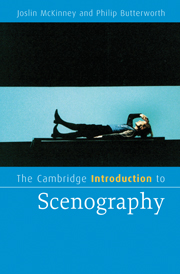Book contents
- Frontmatter
- Contents
- List of illustrations
- List of boxed quotations
- Preface
- Acknowledgements
- Part 1 Elements
- Chapter 1 What is scenography?
- Chapter 2 Twentieth-century pioneers of scenography
- Part 2 Processes of scenography
- Part 3 Realisation and reception
- Notes
- Bibliography
- Index
- Cambridge Introductions to …
Chapter 2 - Twentieth-century pioneers of scenography
Published online by Cambridge University Press: 05 February 2015
- Frontmatter
- Contents
- List of illustrations
- List of boxed quotations
- Preface
- Acknowledgements
- Part 1 Elements
- Chapter 1 What is scenography?
- Chapter 2 Twentieth-century pioneers of scenography
- Part 2 Processes of scenography
- Part 3 Realisation and reception
- Notes
- Bibliography
- Index
- Cambridge Introductions to …
Summary
The previous chapter attempts to determine the nature of scenography and define its territory. In this chapter, emphasis is given to the means by which such definitions have been achieved. What were the influences and who created or promoted them to determine the concept and practice of scenography? It will not be too surprising to know that influences have come from people who represent a number of disparate sources which occupy some common and related ground. Between them they span a range of perspectives and include: artists, designers, directors, writers and performers. These individuals were and are pioneers in their thinking and vision of and for the theatre. Few of them have referred to their thinking in terms of scenography. It is the accumulative contributions of their work that enable such a concept as scenography to be recognised as relevant to the production of theatre today. Each of these pioneers concentrates on points of focus that are distinctive and relevant to the conceptual and practical development of scenography. As might be imagined, there is considerable overlapping of concern between their preoccupations.
Adolphe Appia (1862–1928)
Pioneers of theatre are often labelled as such because their inspiration, thinking and achievement often occur as a result of dissatisfaction with existing theatrical conditions. In the case of Adolphe Appia his frustration lay with the convention of elaborately detailed sets, created from a combination of painted flats, borders and backdrops that fringed the stage and purported to create the illusion of a real place and, in fact, did nothing of the kind.
- Type
- Chapter
- Information
- The Cambridge Introduction to Scenography , pp. 9 - 80Publisher: Cambridge University PressPrint publication year: 2009

